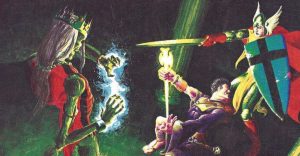Diablo 2: Resurrected – The Best Druid Class Builds

Editor’s Note: A lawsuit has been filed against Activision Blizzard by the California Department of Fair Employment and Housing, which alleges the company has engaged in abuse, discrimination, and retaliation against its female employees. Activision Blizzard has denied the allegations. The full details of the Activision Blizzard lawsuit (content warning: rape, suicide, abuse, harassment) are being updated as new information becomes available.
The remade Diablo 2: Resurrected allows instant access to Lord of Destruction classes like the Druid. All classes in Diablo 2 have the freedom to spend their attribute and skill points as they like, opening up a huge possibility of character builds. However, it can be very overwhelming deciding what to pick for each individual character’s playstyle.
Druids have three available skill trees in Diablo 2: Resurrected: Shape Shifting, Elemental, and Summoning. Unlike other Diablo 2 classes, the Druid is a bit more constrained due to most Elemental spells being inaccessible while in werebeast form (but will still persist if already casted). Additionally, because skills have a required minimum character level (various multiples of six), it is common to save earned skill points and allocate them all when a main attack can be unlocked.
With how versatile Diablo 2’s Druids can be, it may be a bit hard deciding on which attribute points to focus on first. At minimum, all Druids should have enough strength and dexterity to wear their best equipment; additional strength will only improve melee damage by a meager 1%. Energy, meanwhile, is only needed for those going deep into the Elemental tree, while any extra points should go towards vitality.
Focused Builds in Diablo 2: Resurrected

Due to limited amount of skill points in Diablo 2: Resurrected, most Druids may want to specialize in a certain attack or role.
Werewolf: Werewolf is the classic melee skirmisher form of Druid. Its main attack is Fury, gained at level 30, which can hit up to five times at close range. A werewolf can further supplement their abilities with Feral Rage for stronger single enemies, or Hunger to recover life and mana. Because a werewolf is more about damage, one will want to invest in the Werewolf skill first, followed by Lycanthropy after the former is maxed.
Werebear: Werebear is the second shapeshifting option in Diablo 2. Compared to a werewolf it has more survivability, but is slower and inaccurate. These types of Druids will mainly use Maul, gained at level 12, which is similar to Feral Rage but with a stun instead of bonuses to attack. For crowds, werebears may rely on Shock Wave; it is low damage, but hits in an arc and stuns for over ten seconds. Like werewolves, Diablo 2’s werebear Druid will want to put at least some reserve points in Hunger and Lycanthropy.
Summoner: Some Druids may want to focuses entirely on their animal minions. The first decision should be to pick either Summon Grizzly at level 30 or Summon Dire Wolf at level 18. The grizzly is a single durable tank, and the ability to summon up to three wolves offers good options for added damage. Thankfully, the two skills have synergy bonuses with each other, so points spent of either will never be wasted.
Summoners can also have one spirit and one vine active at a time. Heart of the Wolverine will be the most helpful spirit, as it boosts the attack power of every close by ally. Oak Sage is an alright backup for defense, but will make fights last longer. Vines can be harder to use based on Diablo 2 party composition; they consume corpses to function, a resource that may be needed by a friendly Necromancer or Paladin. Conversely, vines can hamper enemies of those classes by devouring corpses before they can. In those situations, Carrion Vine is great for restoring life, and Solar Creeper can be the same but for mana.

Fire Druid: Fire Druids aim to make the most out of the level 30 spell Armageddon. The attack can cause a lot of damage, but its random barrage of falling meteors can be hard to aim. Because of this, it is still a good idea to use the level 6 Molten Boulder and level 24 Volcano for better accuracy. Thankfully, all of these have synergy bonuses, so the points are always improving the others’ damage. The downfall of doing so much fire based damage is that many foes in higher difficulties like Nightmare and Hell are resistant or immune. Thankfully, Molten Boulder and Volcano deal half physical based damage as well.
Wind Druid: Wind-focused Druids mainly use the other level 30 spell, Hurricane. This attack deals a high amount of cold damage in a circle around the Druid (and moves along with them). Because this can also be a difficult spell to aim (especially if enemies are already inside the eye of the storm) it is a good idea to also use level 18 Twister and level 24 Tornado. These two spells deal physical damage, allowing them to harm foes that are cold resistant or immune.
Additional, thanks to synergy bonuses a wind Druid will have very strong Cyclone Armor. This spell will absorb a large amount of fire, cold, or lightning damage before dissipating. This makes the wind Druid great for facing enemy mages in Diablo 2, especially other player Sorceresses and trap Assassins.
Combining Skill Trees in Diablo 2: Resurrected

While focused builds are the most powerful in Hell difficulty, it is also possible to dip into other skills trees or paths while leveling up. For instance, nearly all types of Druid will want Summon Grizzly or Summon Dire Wolf (even if not fully powered) to simply distract enemies. Additionally, while Cyclone Armor will be rather weak for most builds, it can still block a few magic hits each encounter.
Fire Shifter: The Shape Shifting attack Fire Claws is typically rather poor on its own. However, by dipping into the Elemental tree and grabbing Firestorm, Molten Boulder, Fissure, and Volcano, the cross synergies will raise Fire Claws’ damage by 22% per point. This gives melee werewolves and werebears a good elemental option against physical immune enemies.
Rabies Wolf: Rabies is a level 18 ability that allows werewolves to deal poison damage. The base damage is nothing special, but will skyrocket from an investment into the Summoning tree’s Poison Creeper. While total damage will be incredibly high, it does take a while (over ten seconds) for all damage to apply. This typically makes it better for Diablo 2 player versus player fights instead of against waves of monsters.

Dual Elemental: Some Druids in Diablo 2: Resurrected may combine Armageddon, Hurricane, Volcano, and Tornado together. This versatile combination will exploit multiple enemy weaknesses, but the base damage of each attack will only ever be average. Because skill points will be spread thin, this style of Druid will likely have the worst summons (or even none at all).
Still, even with glaring flaws any build in Diablo 2 can be compensated with good equipment. This includes high level unique armor, runeword combinations, and inventory charms. This can make it hard to plan builds for completely fresh Druids, but with a shared account stash each additional character will have a leg up.
Diablo 2: Resurrected is available on PlayStation 4, PlayStation 5, Xbox One, Xbox Series X, Nintendo Switch and PC.
About The Author

















